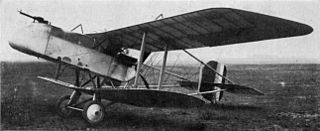
Between 1911 and 1914, the Royal Aircraft Factory used the F.E.2 designation for three quite different aircraft that shared only a common "Farman" pusher biplane layout.

The Vickers F.B.5 was a British two-seat pusher military biplane of the First World War. Armed with a single .303 in (7.7 mm) Lewis gun operated by the observer in the front of the nacelle, it was the first aircraft purpose-built for air-to-air combat to see service, making it the world's first operational fighter aircraft.

The Vickers Virginia was a biplane heavy bomber of the British Royal Air Force, developed from the Vickers Vimy.

The Fairey Hendon was a British monoplane, heavy bomber of the Royal Air Force, designed by Fairey Aviation in the late 1920s. The aircraft served in small numbers with one squadron of the RAF between 1936 and 1939. It was the first all-metal low-wing monoplane to enter service with the RAF.

The Sopwith 5F.1 Dolphin was a British fighter aircraft manufactured by the Sopwith Aviation Company. It was used by the Royal Flying Corps and its successor, the Royal Air Force, during the First World War. The Dolphin entered service on the Western Front in early 1918 and proved to be a formidable fighter. The aircraft was not retained in the postwar inventory and was retired shortly after the war.

The Vickers F.B.19 was a British single-seat fighting scout of the First World War, developed from the Barnwell Bullet prototype, and sometimes known as the Vickers Bullet. It served with the Royal Flying Corps and the Imperial Russian Air Service, which subsequently led to the Red Air Force adopting it during the Russian Civil War.

The QF 3-inch 20 cwt anti-aircraft gun became the standard anti-aircraft gun used in the home defence of the United Kingdom against German Zeppelins airships and bombers and on the Western Front in World War I. It was also common on British warships in World War I and submarines in World War II. 20 cwt referred to the weight of the barrel and breech, to differentiate it from other 3-inch guns. While other AA guns also had a bore of 3 inches (76 mm), the term 3-inch was only ever used to identify this gun in the World War I era, and hence this is what writers are usually referring to by 3-inch AA gun.
The Sopwith 8F.1 Snail was a prototype British Fighter aircraft of the First World War. It was unsuccessful, being abandoned due to an unreliable engine.

The Austin A.F.T.3 Osprey was a prototype British fighter triplane of the First World War. Developed by the motor car manufacturer Austin as a replacement to the Sopwith Camel, only one was built, the Sopwith Snipe being preferred.
The Sopwith 2FR.2 Bulldog was a prototype British two-seat fighter of the First World War. A single-engined biplane, the Bulldog was a fighter/reconnaissance aircraft intended to replace the Bristol F.2 Fighter, but was unsuccessful, with no replacement for the Bristol Fighter being purchased.
The Sopwith Long Range Tractor Triplane (L.R.T.Tr) was a prototype British long-range three-seat triplane escort fighter of the First World War. Its unusual layout had a small gunner's nacelle mounted on the upper wing for an all-round field of fire. Only a single example was built, as other, smaller fighters proved more practicable.

The Vickers E.F.B.7 was a prototype British fighter aircraft of the First World War. A twin-engined biplane, the E.F.B.7 was unsuccessful, only one being built.
The Vickers E.F.B.8 was a prototype British twin-engined fighter of the First World War. It was abandoned after only one aircraft was built, single-engined fighters being considered to have superior manoeuvrability.

The Royal Aircraft Factory F.E.9 was a prototype British two-seat fighter-reconnaissance aircraft of the First World War. A single-engined pusher biplane of 1917, the F.E.9 had poor performance and handling, and only three were built.
The Sopwith 3F.2 Hippo was a prototype British two-seat fighter aircraft of the First World War. It was a single-engined biplane with considerable negative stagger. It was not successful, the Bristol F.2 Fighter being preferred by the Royal Flying Corps.
The Royal Aircraft Factory F.E.3 (also known as the A.E.1 was a British experimental single-engined pusher biplane built prior to the First World War. It was intended to be fitted with a shell-firing gun, but was quickly abandoned, being found to be structurally unsound.

The Vickers F.B.16 was a British single-seat fighter aircraft of the First World War. It was originally designed to be powered by an experimental radial engine, development of which was abandoned. When re-engined with more powerful and reliable water-cooled V-8 engines, the F.B.16 demonstrated good performance, but only a few prototypes were built, the type not entering service.

The Vickers F.B.25 was a British two-seat night fighter prototype of World War I designed to attack enemy airships. Completed in 1917, it failed in its official flight tests that year and no order for production resulted.

The 1.59-inch breech-loading Vickers Q.F. gun, Mk II was a British light artillery piece designed during World War I. Originally intended for use in trench warfare, it was instead tested for air-to-air and air-to-ground use by aircraft. Although it fired shells and had no capability to launch rockets, it was widely but misleadingly known as the "Vickers-Crayford rocket gun."
The Vickers E.F.B.1 'Destroyer' was an early British military aircraft prototype. Although not itself a success, the design was considered worth developing, and a series of similar aircraft were produced in prototype form, eventually leading to the Vickers F.B.5 "Gunbus", which saw widespread service during World War I.













